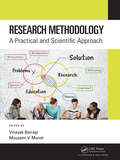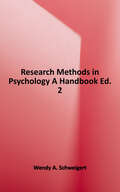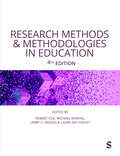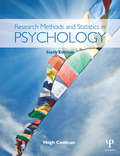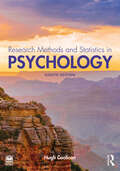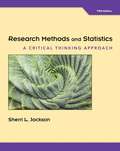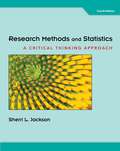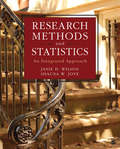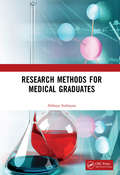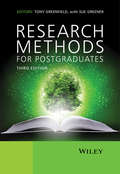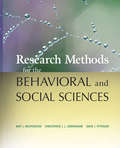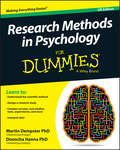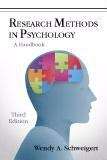- Table View
- List View
Research Methodology: A Practical and Scientific Approach
by Vinayak Bairagi Mousami V. MunotThis book offers a design research methodology intended to improve the quality of design research- its academic credibility, industrial significance and societal contribution by enabling more thorough, efficient and effective procedures.
Research Methodology: Best Practices for Rigorous, Credible, and Impactful Research
by Herman AguinisResearch Methodology: Best Practices for Rigorous, Credible, and Impactful Research takes a 360-degree view of understanding and doing research, helping readers become expert researchers, reviewers, and consumers of research. Renowned author, journal editor, and researcher Herman Aguinis distills the vast body of work on methodological best practices into a singular experience. Each of the 16 chapters thoroughly explains a different aspect of methodology step by step, from choosing useful and compelling research topics to reporting results accurately and credibly. Researchers at all career stages will find this text helpful to structure and conduct high-impact empirical research aimed at producing a thesis, dissertation, or journal publication. Research consumers will find instruction on how to evaluate the rigor and credibility of research conducted by others. Instructors will find the book’s modular approach refreshing by assigning students the most relevant topics—from checklists of best practices to an in-depth treatment of a methodology. Filled with "how-to’s" and "dos and don’ts", figures, hands-on exercises, and "Methods in Practice" boxes that summarize and apply best practices, this book is a must-have for anyone interested in producing or reading research. Included with this title: LMS Cartridge: Import this title’s instructor resources into your school’s learning management system (LMS) and save time. Don’t use an LMS? You can still access all of the same online resources for this title via the password-protected Instructor Resource Site. Learn more.
Research Methodology: Best Practices for Rigorous, Credible, and Impactful Research
by Herman AguinisResearch Methodology: Best Practices for Rigorous, Credible, and Impactful Research takes a 360-degree view of understanding and doing research, helping readers become expert researchers, reviewers, and consumers of research. Renowned author, journal editor, and researcher Herman Aguinis distills the vast body of work on methodological best practices into a singular experience. Each of the 16 chapters thoroughly explains a different aspect of methodology step by step, from choosing useful and compelling research topics to reporting results accurately and credibly. Researchers at all career stages will find this text helpful to structure and conduct high-impact empirical research aimed at producing a thesis, dissertation, or journal publication. Research consumers will find instruction on how to evaluate the rigor and credibility of research conducted by others. Instructors will find the book’s modular approach refreshing by assigning students the most relevant topics—from checklists of best practices to an in-depth treatment of a methodology. Filled with "how-to’s" and "dos and don’ts", figures, hands-on exercises, and "Methods in Practice" boxes that summarize and apply best practices, this book is a must-have for anyone interested in producing or reading research. Included with this title: LMS Cartridge: Import this title’s instructor resources into your school’s learning management system (LMS) and save time. Don’t use an LMS? You can still access all of the same online resources for this title via the password-protected Instructor Resource Site. Learn more.
Research Methodology: Techniques and Trends
by D P Kothari Umesh Kumar DubeyResearch Methodology: Techniques and Trends focuses on both undergraduate and post graduate courses; and it helps readers understand the basic concepts and the application of results directly to real life business, industry and research organizations. Features: Review questions are included at the end of each chapter, to test conceptual understanding of the subject and put theory into practice, which help in the understanding of key concepts and ideas. In-depth coverage of concepts and techniques. Tables and figures are presented to illustrate the concepts and techniques. Provides students with essential guidance on how to carry out their own research projects. Covers a wide range of research methods, approaches to research, and ways of carrying out analysis of data. This is a textbook on research methodology for doctoral and post-doctoral programs; post graduate courses such as MSc, MBA, MCA, MS, etc., to name a few. Though the book is primarily addressed to students, it is equally useful to researchers and entrepreneurs as well.
Research Methods In Psychology: A Handbook
by Wendy A. SchweigertPerfect as a main text or as a supplement, this versatile handbook is ideal for psychology courses devoted specifically to research methods as well as for more general psychology courses with a research component. Each chapter independently covers a commonly used research method, giving instructors the flexibility to assign chapters in a way that meets the needs of their own classes. Chapter outlines, concept questions and exercises (along with a selected set of answers), lists of important terms and concepts, and written explanations of basic statistical techniques supplemented with illustrative statistical tables are among the book's many outstanding features. Basic guidelines of how to write, format, and publish results demonstrate an astute, hands-on approach to conducting research in psychology.
Research Methods and Data Analysis for Business Decisions: A Primer Using SPSS (Classroom Companion: Business)
by James E. Sallis Geir Gripsrud Ulf Henning Olsson Ragnhild SilkosetThis introductory textbook presents research methods and data analysis tools in non-technical language. It explains the research process and the basics of qualitative and quantitative data analysis, including procedures and methods, analysis, interpretation, and applications using hands-on data examples in QDA Miner Lite and IBM SPSS Statistics software. The book is divided into four parts that address study and research design; data collection, qualitative methods and surveys; statistical methods, including hypothesis testing, regression, cluster and factor analysis; and reporting. The intended audience is business and social science students learning scientific research methods, however, given its business context, the book will be equally useful for decision-makers in businesses and organizations.
Research Methods and Methodologies in Education
by Michael Waring Robert Coe Laura Day Ashley Larry V HedgeYour #1 resource for carrying out educational research as part of postgraduate study. High-quality educational research requires careful consideration of every aspect of the process. This all-encompassing textbook written by leading international experts gives you a considered overview of the principles that underpin research, and key qualitative, quantitative and mixed methods for research design, data collection and analysis. This fourth edition includes four new chapters on: Doing a literature review Measurement and validity Using R (with RStudio & Tidyverse) Data transparency, reproducibility, and replicability In addition, across the book, authors touch on the emergent use of generative AI tools as part of the educational research process. Also, chapters have been reordered to better reflect the research process and to emphasise commonalities between methodological approaches and tools. This is essential reading for postgraduate students on education courses and early career researchers looking to sharpen their research practice.
Research Methods and Methodologies in Education
by Michael Waring Robert Coe Laura Day Ashley Larry V HedgeYour #1 resource for carrying out educational research as part of postgraduate study. High-quality educational research requires careful consideration of every aspect of the process. This all-encompassing textbook written by leading international experts gives you a considered overview of the principles that underpin research, and key qualitative, quantitative and mixed methods for research design, data collection and analysis. This fourth edition includes four new chapters on: Doing a literature review Measurement and validity Using R (with RStudio & Tidyverse) Data transparency, reproducibility, and replicability In addition, across the book, authors touch on the emergent use of generative AI tools as part of the educational research process. Also, chapters have been reordered to better reflect the research process and to emphasise commonalities between methodological approaches and tools. This is essential reading for postgraduate students on education courses and early career researchers looking to sharpen their research practice.
Research Methods and Methodologies in Education
by Michael Waring Robert Coe Larry V Hedges Laura Day AshleyYour #1 resource for carrying out educational research as part of postgraduate study. High-quality educational research requires careful consideration of every aspect of the process. This all-encompassing textbook written by leading international experts gives you considered overview of principles that underpin research, and key qualitative, quantitative and mixed methods for research design, data collection and analysis. This third edition includes four new chapters: Disseminating your research Data science and computational research methods Observational methods Analysis of variance (ANOVA) Plus a new Research essentials feature that highlights key ‘must-haves’ or misconceptions relating to each methodological approach, research design or analytical tool discussed. This is essential reading for postgraduate students on education courses and early career researchers looking to sharpen their research practice.
Research Methods and Methodologies in Education
by Michael Waring Robert Coe Larry V Hedges Laura Day AshleyYour #1 resource for carrying out educational research as part of postgraduate study. High-quality educational research requires careful consideration of every aspect of the process. This all-encompassing textbook written by leading international experts gives you considered overview of principles that underpin research, and key qualitative, quantitative and mixed methods for research design, data collection and analysis. This third edition includes four new chapters: Disseminating your research Data science and computational research methods Observational methods Analysis of variance (ANOVA) Plus a new Research essentials feature that highlights key ‘must-haves’ or misconceptions relating to each methodological approach, research design or analytical tool discussed. This is essential reading for postgraduate students on education courses and early career researchers looking to sharpen their research practice.
Research Methods and Statistics
by Bernard C. Beins Maureen A. McCarthyThinking critically about research and data analysis Beins and McCarthy present a seamless introduction to statistics and research methods, identifying different research areas and how one approaches them statistically. The text is designed for a one- or two-semester combined course in Statistics and Research Methods/Experimental Psychology. It helps students develop critical thinking skills about research and data analysis they see in the news and to evaluate claims people make based on that research. Teaching & Learning Experience Improve Critical Thinking - The entire text helps students develop critical thinking skills about research and data analysis they see in the news and to evaluate claims people make about research. Support Instructors - MyTest, PowerPoints, and an instructor's manual offer additional support for instructors.
Research Methods and Statistics in Psychology
by Hugh CoolicanThis sixth edition of Research Methods and Statistics in Psychology has been fully revised and updated, providing students with the most readable and comprehensive survey of research methods, statistical concepts and procedures in psychology today. Assuming no prior knowledge, this bestselling text takes you through every stage of your research project giving advice on planning and conducting studies, analysing data and writing up reports. The book provides clear coverage of statistical procedures, and includes everything needed from nominal level tests to multi-factorial ANOVA designs, multiple regression and log linear analysis. It features detailed and illustrated SPSS instructions for all these procedures eliminating the need for an extra SPSS textbook. New features in the sixth edition include: "Tricky bits" - in-depth notes on the things that students typically have problems with, including common misunderstandings and likely mistakes. Improved coverage of qualitative methods and analysis, plus updates to Grounded Theory, Interpretive Phenomenological Analysis and Discourse Analysis. A full and recently published journal article using Thematic Analysis, illustrating how articles appear in print. Discussion of contemporary issues and debates, including recent coverage of journals' reluctance to publish replication of studies. Fully updated online links, offering even more information and useful resources, especially for statistics. Each chapter contains a glossary, key terms and newly integrated exercises, ensuring that key concepts are understood. A companion website (www.routledge.com/cw/coolican) provides additional exercises, revision flash cards, links to further reading and data for use with SPSS.
Research Methods and Statistics in Psychology
by Hugh CoolicanThe seventh edition of Research Methods and Statistics in Psychology provides students with the most readable and comprehensive survey of research methods, statistical concepts and procedures in psychology today. Assuming no prior knowledge, this bestselling text takes you through every stage of your research project giving advice on planning and conducting studies, analysing data and writing up reports. The book provides clear coverage of experimental, interviewing and observational methods, psychological testing, qualitative methods and analysis and statistical procedures which include nominal level tests, multi-factorial ANOVA designs, multiple regression, log linear analysis, and factor analysis. It features detailed and illustrated SPSS instructions for all these and other procedures, eliminating the need for an extra SPSS textbook. New features to this edition include: Additional coverage of factor analysis and online and modern research methods Expanded coverage of report writing guidelines References updated throughout Presentation updated throughout, to include more figures, tables and full colour to help break up the text Companion website signposted throughout the book to improve student usability Improved and extended web links and further reading associated with every chapter. Each chapter contains a glossary, key terms and newly integrated exercises, ensuring that key concepts are understood. A fully updated companion website (www.routledge.com/cw/coolican) provides additional exercises, testbanks for each chapter, revision flash cards, links to further reading and data for use with SPSS.
Research Methods and Statistics in Psychology
by Hugh CoolicanResearch Methods and Statistics in Psychology provides students with the most readable and comprehensive survey of research methods, statistical concepts and procedures in psychology today. Assuming no prior knowledge, this bestselling text takes you through every stage of your research project, giving advice on planning and conducting studies, analysing data and writing up reports, both quantitative and qualitative. It incorporates diversity and includes a large section on cross-cultural psychology methods and issues. The book continues its long tradition of integrating qualitative issues into methods chapters as well as providing two chapters dedicated to qualitative methods. It provides clear coverage of experimental, interviewing and observational methods; psychological testing; and statistical procedures which include nominal-level tests, ordinal and interval two-condition tests, simple and multi-factorial ANOVA designs, correlation, multiple regression, log linear analysis, factor analysis and, new with this edition, logistic regression. It features detailed and illustrated SPSS instructions for all these and other procedures, eliminating the need for an extra SPSS textbook. New edition features include: • Logistic regression. • Greater detail of online research methods. • Expanded coverage of report writing guidelines. • Concepts illustrated with up-to-date published research examples. • Instructor and Student Resource website signposted throughout the book to improve student usability. Each chapter contains a glossary, key terms and newly integrated exercises, ensuring that key concepts are understood. This book is extended and enhanced by a fully updated and refreshed Instructor and Student Resource website, which includes: • A collection of interactive multiple-choice questions with detailed feedback, providing the opportunity to test understanding at different levels. • Practical exercises that give students the opportunity to put their learning into practice. • Links to further reading and sources to expand knowledge. • Test banks for each chapter to save instructors time. Access the website at: www.routledge.com/cw/coolican.
Research Methods and Statistics: A Critical Thinking Approach (5th Edition)
by Sherri L. JacksonRESEARCH METHODS AND STATISTICS: A CRITICAL THINKING APPROACH, 5th Edition, successfully illustrates the integration between statistics and research methods by demonstrating the ways to use statistics in analyzing data collected during research. Jackson's combined text adopts an inviting narrative style that speaks directly to students and draws them into the material, helping them overcome the initial apprehension they may feel at having to learn both subject areas at once. Focusing on the logic of the process and the methodology aspect of research, Jackson incorporates a student-friendly critical-thinking approach and presents examples and exercises to which students can relate.
Research Methods and Statistics: A Critical Thinking Approach,Fourth Edition
by Sherri L. JacksonRESEARCH METHODS AND STATISTICS: A CRITICAL THINKING APPROACH, 4e, successfully illustrates the integration between statistics and research methods by demonstrating the ways to use statistics in analyzing data collected during research. Jackson's combined text adopts an inviting narrative style that draws you into the material, helping you overcome the initial apprehension you may feel at having to learn both subject areas at once. She incorporates a student-friendly critical-thinking approach and presents examples and exercises to which you can relate. Jackson focuses on the logic of the process and the methodology aspect of research.
Research Methods and Statistics: An Integrated Approach
by Janie H. Wilson Shauna W. JoyeThis innovative text offers a completely integrated approach to teaching research methods and statistics by presenting a research question accompanied by the appropriate methods and statistical procedures needed to address it. Research questions and designs become more complex as chapters progress, building on simpler questions to reinforce student learning. Using a conversational style and research examples from published works, this comprehensive book walks readers through the entire research process and includes ample pedagogical support for SPSS, Excel, and APA style.
Research Methods and Statistics: An Integrated Approach
by Janie H. Wilson Shauna W. JoyeThis innovative text offers a completely integrated approach to teaching research methods and statistics by presenting a research question accompanied by the appropriate methods and statistical procedures needed to address it. Research questions and designs become more complex as chapters progress, building on simpler questions to reinforce student learning. Using a conversational style and research examples from published works, this comprehensive book walks readers through the entire research process and includes ample pedagogical support for SPSS, Excel, and APA style.
Research Methods for Everyday Life
by Deidre D. Johnson Scott W. VanderstoepThis book offers an innovative introduction to social research. The book explores all stages of the research process and it features both quantitative and qualitative methods. Research design topics include sampling techniques, choosing a research design, and determining research question that inform public opinion and direct future studies. Throughout the book, the authors provide vivid and engaging examples that reinforce the reading and understanding of social science research. "Your Turn" boxes contain activities that allow students to practice research skills, such as sampling, naturalistic observation, survey collection, coding, analysis, and report writing.
Research Methods for Medical Graduates
by Abhaya IndrayanThis book discusses the why and how of each step of data-based medical research that can provide basic information to emerging researchers and medical graduate students who write theses or publish articles. The chapters are arranged in the sequence of steps for data-based research. The research steps are comprehensively covered from the selection of the topic to the final publication. Reporting methods such as CONSORT, STARD, and SAMPL guidelines are also covered. Each chapter has separately earmarked examples from the contemporary literature that illustrate the different research methods. Key Features Discusses all the steps of data-based medical research Examines the topics in depth by way of examples from contemporary literature Features notable information in boxes for special attention .
Research Methods for Postgraduates
by Tony Greenfield Sue GreenerResearch Methods for Postgraduates brings together guidance for postgraduate students on how to organise, plan and do research from an interdisciplinary perspective. In this new edition, the already wide-ranging coverage is enhanced by the addition of new chapters on social media, evaluating the research process, Kansei engineering and medical research reporting. The extensive updates also provide the latest guidance on issues relevant to postgraduates in all subject areas, from writing a proposal and securing research funds, to data analysis and the presentation of research, through to intellectual property protection and career opportunities. This thoroughly revised new edition provides: Clear and concise advice from distinguished international researchers on how to plan, organise and conduct research. New chapters explore social media in research, evaluate the research process, Kansei engineering and discuss the reporting of medical research. Check lists and diagrams throughout.
Research Methods for the Behavioral and Social Sciences
by Christopher J. Cunningham Bart L. Weathington David J. PittengerA comprehensive introduction to research methods and best practices for designing,conducting, interpreting, and reporting findings This text is designed to develop in students a passion for conducting research and an understanding of the practical value of systematic information- gathering and decision-making. It features step-by-step coverage of the research process including research design, statistical considerations, and guidance on writing up and presenting results. Recognized leaders in the field—authors Bart Weathington, Christopher Cunningham, and David Pittenger—present: Introductions to multiple research designs—including single-participant, multi-group, longitudinal, correlational, and experimental designs—accompanied by examples Bibliographic research and methods for appropriate sampling Identifying, developing, and evaluating reliable and valid approaches to measurement The issues and steps common to all single-factor and multifactor studies, as well as single-subject and nonexperimental methods How to summarize research in writing that conforms to the editorial guidelines of the American Psychological Association A comprehensive review of research methods and the statistical concepts that support them, Research Methods for the Behavioral and Social Sciences offers the best techniques for studying behavior and social phenomena.
Research Methods in Psychology For Dummies
by Donncha Hanna Martin DempsterYour hands-on introduction to research methods in psychology Looking for an easily accessible overview of research methods in psychology? This is the book for you! Whether you need to get ahead in class, you're pressed for time, or you just want a take on a topic that's not covered in your textbook, Research Methods in Psychology For Dummies has you covered. Written in plain English and packed with easy-to-follow instruction, this friendly guide takes the intimidation out of the subject and tackles the fundamentals of psychology research in a way that makes it approachable and comprehensible, no matter your background. Inside, you'll find expert coverage of qualitative and quantitative research methods, including surveys, case studies, laboratory observations, tests and experiments--and much more. Serves as an excellent supplement to course textbooks Provides a clear introduction to the scientific method Presents the methodologies and techniques used in psychology research Written by the authors of Psychology Statistics For Dummies If you're a first or second year psychology student and want to supplement your doorstop-sized psychology textbook--and boost your chances of scoring higher at exam time--this hands-on guide breaks down the subject into easily digestible bits and propels you towards success.
Research Methods in Psychology: A Handbook
by Wendy A. SchweigertThis handbook provides a brief but thorough introduction to the most commonly used research methods in psychology (as well as a number of related topics such as statistics, ethics, and literature searches). The book includes much of the same information presented in longer texts, but in a more succinct format.
Research Methods, Statistics, and Applications
by Kathrynn A. Adams Eva Kung McGuire (aka: Lawrence)Research Methods, Statistics, and Applications by Kathrynn A. Adams and Eva K. McGuire is designed to give students the experience of being a researcher by combining the interrelated concepts of research methods and statistics to better explain how the research process incorporates both elements. Employing a conversational tone throughout, coupled with an emphasis on decision-making, this best-selling text will spark students’ interest in conducting research and improve their ability to critically analyze research in their daily lives. The Third Edition includes a new chapter on measurement to better highlight its critical importance, updates for the 7th edition of the Publication Manual of the American Psychological Association, new examples related to social justice, additional sections on qualitative research methods, and more thorough integration of research ethics information and tips throughout each chapter.
